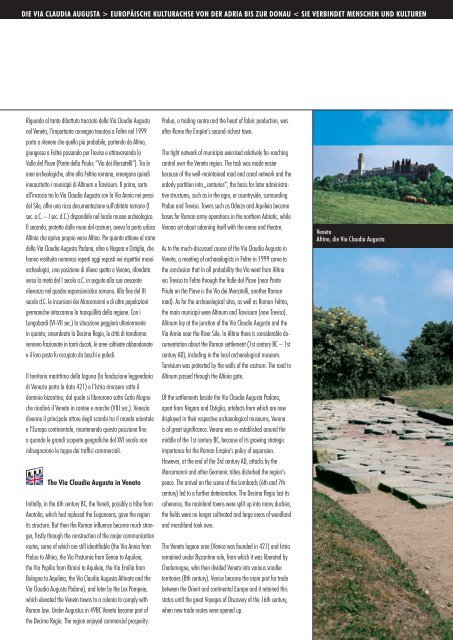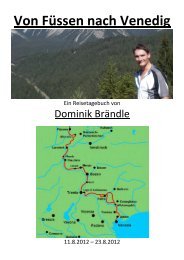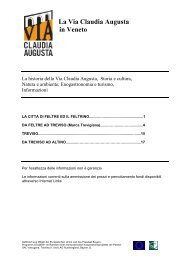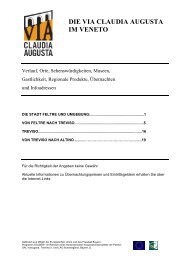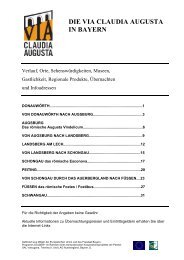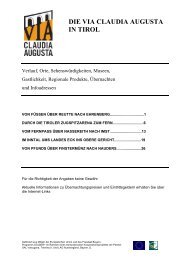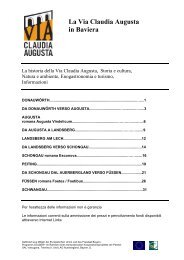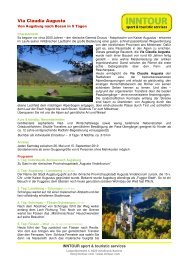VIA CLAUDIA AUGUSTA SALESGUIDE
VIA CLAUDIA AUGUSTA SALESGUIDE
VIA CLAUDIA AUGUSTA SALESGUIDE
You also want an ePaper? Increase the reach of your titles
YUMPU automatically turns print PDFs into web optimized ePapers that Google loves.
die ViA ClAudiA AugusTA > europäisChe kulTurAChse Von der AdriA bis zur donAu < sie VerbindeT mensChen und kulTuren<br />
Riguardo al tanto dibattuto tracciato della Via Claudia Augusta<br />
nel Veneto, l’importante convegno tenutosi a Feltre nel 1999<br />
porta a ritenere che quello più probabile, partendo da Altino,<br />
giungesse a Feltre passando per Treviso e attraversando la<br />
Valle del Piave (Ponte della Priula: “Via dei Mercatelli”). Tra le<br />
aree archeologiche, oltre alla Feltria romana, emergono quindi<br />
innanzitutto i municipii di Altinum e Tarvisium. Il primo, sorto<br />
all’incrocio tra la Via Claudia Augusta con la Via Annia nei pressi<br />
del Sile, offre una ricca documentazione sull’abitato romano (I<br />
sec. a.C. – I sec. d.C.) disponibile nel locale museo archeologico.<br />
Il secondo, protetto dalle mura del castrum, aveva la porta urbica<br />
Altinia che apriva proprio verso Altino. Per quanto attiene al ramo<br />
della Via Claudia Augusta Padana, oltre a Nogara e Ostiglia, che<br />
hanno restituito numerosi reperti oggi esposti nei rispettivi musei<br />
archeologici, una posizione di rilievo spetta a Verona, rifondata<br />
verso la metà del I secolo a.C. in seguito alla sua crescente<br />
rilevanza nel quadro espansionistico romano. Alla fine del III<br />
secolo d.C. le incursioni dei Marcomanni e di altre popolazioni<br />
germaniche intaccarono la tranquillità della regione. Con i<br />
Longobardi (VI-VII sec.) la situazione peggiorò ulteriormente<br />
in quanto, smembrata la Decima Regio, le città di terraferma<br />
vennero frazionate in tanti ducati, le aree coltivate abbandonate<br />
e il loro posto fu occupato da boschi e paludi.<br />
Il territorio marittimo della laguna (la fondazione leggendaria<br />
di Venezia porta la data 421) e l’Istria rimasero sotto il<br />
dominio bizantino, dal quale si liberarono sotto Carlo Magno<br />
che riordinò il Veneto in contee e marche (VIII sec.). Venezia<br />
divenne il principale attore degli scambi tra il mondo orientale<br />
e l’Europa continentale, mantenendo questa posizione fino<br />
a quando le grandi scoperte geografiche del XVI secolo non<br />
ridisegnarono le tappe dei traffici commerciali.<br />
The Via Claudia Augusta in Veneto<br />
Initially, in the 6th century BC, the Veneti, possibly a tribe from<br />
Anatolia, which had replaced the Euganeans, gave the region<br />
its structure. But then the Roman influence become much stronger,<br />
firstly through the construction of the major communication<br />
routes, some of which are still identifiable (the Via Annia from<br />
Padua to Altino, the Via Postumia from Genoa to Aquileia,<br />
the Via Popilia from Rimini to Aquileia, the Via Emilia from<br />
Bologna to Aquileia, the Via Claudia Augusta Altinate and the<br />
Via Claudia Augusta Padana), and later by the Lex Pompeia,<br />
which elevated the Veneto towns to a colonia to comply with<br />
Roman law. Under Augustus in 49BC Veneto became part of<br />
the Decima Regio. The region enjoyed commercial prosperity.<br />
Padua, a trading centre and the heart of fabric production, was<br />
after Rome the Empire‘s second-richest town.<br />
The tight network of municipia exercised relatively far-reaching<br />
control over the Veneto region. The task was made easier<br />
because of the well-maintained road and canal network and the<br />
orderly partition into „centuries“, the basis for later administrative<br />
structures, such as in the agro, or countryside, surrounding<br />
Padua and Treviso. Towns such as Oderzo and Aquileia became<br />
bases for Roman army operations in the northern Adriatic, while<br />
Verona set about adorning itself with the arena and theatre.<br />
As to the much-discussed course of the Via Claudia Augusta in<br />
Veneto, a meeting of archaeologists in Feltre in 1999 came to<br />
the conclusion that in all probability the Via went from Altino<br />
via Treviso to Feltre through the Valle del Piave (near Ponte<br />
Priula on the Piave is the Via dei Mercatelli, another Roman<br />
road). As for the archaeological sites, as well as Roman Feltria,<br />
the main municipii were Altinum and Tarvisium (now Treviso).<br />
Altinum lay at the junction of the Via Claudia Augusta and the<br />
Via Annia near the River Sile. In Altino there is considerable documentation<br />
about the Roman settlement (1st century BC – 1st<br />
century AD), including in the local archaeological museum.<br />
Tarvisium was protected by the walls of the castrum. The road to<br />
Altinum passed through the Altinia gate.<br />
Of the settlements beside the Via Claudia Augusta Padana,<br />
apart from Nogara and Ostiglia, artefacts from which are now<br />
displayed in their respective archaeological museums, Verona<br />
is of great significance. Verona was re-established around the<br />
middle of the 1st century BC, because of its growing strategic<br />
importance for the Roman Empire‘s policy of expansion.<br />
However, at the end of the 3rd century AD, attacks by the<br />
Marcomanni and other Germanic tribes disturbed the region‘s<br />
peace. The arrival on the scene of the Lombards (6th and 7th<br />
century) led to a further deterioration. The Decima Regio lost its<br />
coherence, the mainland towns were split up into many duchies,<br />
the fields were no longer cultivated and large areas of woodland<br />
and marshland took over.<br />
The Veneto lagoon area (Venice was founded in 421) and Istria<br />
remained under Byzantine rule, from which it was liberated by<br />
Charlemagne, who then divided Veneto into various smaller<br />
territories (8th century). Venice became the main port for trade<br />
between the Orient and continental Europe and it retained this<br />
status until the great Voyages of Discovery of the 16th century,<br />
when new trade routes were opened up.<br />
Veneto<br />
Altino, die Via Claudia Augusta


